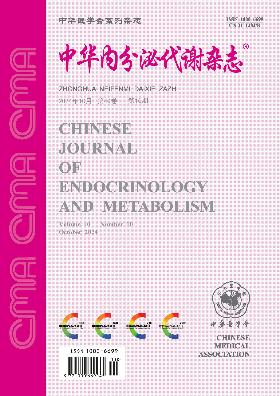The characteristics and clinical significance of serum TRAb IgG subtype in patients with thyroid associated ophthalmopathy
Q4 Medicine
引用次数: 1
Abstract
Objective To explore the distribution of serum TRAb IgG subtypes in patients with thyroid-associated ophthalmopathy(TAO) at different stages and its value in assessing TAO activity. Methods Forty-three patients with TAO, 30 patients with Graves′ disease (GD group), 19 patients with Hashimoto′s thyroiditis (HT group), and 50 healthy subjects (NC group)admitted to the First Affiliated Hospital of Zhengzhou University were collected from August 2018 to February 2019. According to the clinical activity score (CAS), the patients with TAO were further divided into the active period group (AP group, CAS≥3 points, 22 cases) and the inactive period group (IP group, CAS<3 points, 21 cases). The basic clinical data of subjects in each group were collected. The serum concentrations of FT3, FT4, TSH, thyroperoxidase antibody (TPOAb), thyroglobulin antibody (TgAb), and thyroid-stimulating hormone receptor antibody (TRAb) were detected by chemiluminescence immunoassay and the binding rate in percentage (B) of serum TRAb IgG and IgG subtypes were detected by ELISA. The positive rate in each group and relative content of positive samples were compared. Results (1)Compared with HT group, the positive rates of IgG1 and IgG2 in TAO group and GD group were significantly decreased (P 0.05). (2)Compared with the IP group, IgG1(B) and the positive rates of IgG1 in the AP group were increased while IgG4(B) and the relative contents of IgG4 were reduced (P<0.05). (3)IgG1(B)was positively correlated with TAO activity (B=6.190, P=0.007), and higher IgG4(B)indicated more inclinations to the inactive period (B=-16.390, P=0.052). (4) The area under the curve of receiver operating characteristic (ROC) for TAO developing into active period assessed by activity rate was 0.859 (95%CI 0.746-0.973, P<0.05). When the activity rate was 4.29, the Jordon index showed the largest, with sensitivity of 81.8% and specificity of 81.0%. Conclusions Elevated levels of TRAb IgG1 in the patients with TAO indicate a tendency to active period, while elevated levels of TRAb IgG4 indicate a tendency to inactive period. The activity rate can provide a reference for assessing whether TAO is active or not. Key words: Thyroid-associated ophthalmopathy; IgG subtype; Clinical activity score甲状腺相关性眼病患者血清TRAb IgG亚型特征及临床意义
目的探讨血清TRAb-IgG亚型在不同阶段甲状腺相关眼病(TAO)患者中的分布及其在评估TAO活性中的价值。方法收集郑州大学第一附属医院2018年8月至2019年2月收治的43例TAO患者、30例Graves病患者(GD组)、19例桥本甲状腺炎患者(HT组)和50名健康受试者(NC组)。根据临床活动评分(CAS),将TAO患者进一步分为活动期组(AP组,CAS≥3分,22例)和非活动期组,IP组,CAS<3分,21例)。收集各组受试者的基本临床数据。用化学发光免疫法检测血清FT3、FT4、TSH、甲状腺过氧化物酶抗体(TPOAb)、甲状腺球蛋白抗体(TgAb)和促甲状腺激素受体抗体(TRAb)的浓度,用ELISA法检测血清TRAb-IgG和IgG亚型的结合率(以百分比(B)计)。比较各组的阳性率和阳性样本的相对含量。结果(1)与HT组相比,TAO组和GD组IgG1和IgG2的阳性率均显著降低(P<0.05),IgG4(B)越高,则越倾向于非活动期(B=-16.390,P=0.052)。(4)以活动率评估的TAO发展为活动期的受试者操作特征曲线下面积为0.859(95%CI 0.746-0.973,P<0.05)。当活动率为4.29时,Jordon指数最大,结论TAO患者TRAb-IgG1水平升高提示有活动期倾向,TRAb-IgG4水平升高提示无活动期倾向。活动率可以为评估TAO是否活跃提供参考。关键词:甲状腺相关眼病;IgG亚型;临床活动评分
本文章由计算机程序翻译,如有差异,请以英文原文为准。
求助全文
约1分钟内获得全文
求助全文
来源期刊

中华内分泌代谢杂志
Medicine-Endocrinology, Diabetes and Metabolism
CiteScore
0.60
自引率
0.00%
发文量
7243
期刊介绍:
The Chinese Journal of Endocrinology and Metabolism was founded in July 1985. It is a senior academic journal in the field of endocrinology and metabolism sponsored by the Chinese Medical Association. The journal aims to be the "Chinese broadcaster of new knowledge on endocrinology and metabolism worldwide". It reports leading scientific research results and clinical diagnosis and treatment experience in endocrinology and metabolism and related fields, as well as basic theoretical research that has a guiding role in endocrinology and metabolism clinics and is closely integrated with clinics. The journal is a core journal of Chinese science and technology (a statistical source journal of Chinese science and technology papers), and is included in Chinese and foreign statistical source journal databases such as the Chinese Science and Technology Papers and Citation Database, Chemical Abstracts, and Scopus.
 求助内容:
求助内容: 应助结果提醒方式:
应助结果提醒方式:


